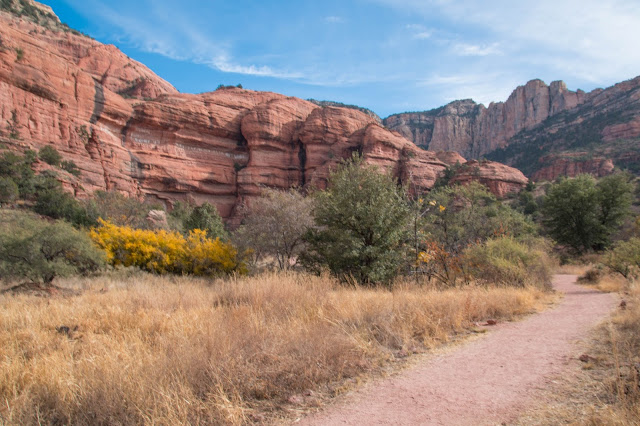Wednesday, November 15th
Happy 61st Birthday Ray.
I asked him if he felt a year older ... he said doesn't feel a day over 81. Pour guy ... his back is like an 85 year old man's according to his Neurologist and that was 5 years ago. This is why we keep pressing on to see stuff before he can't.
We had a beautiful sunrise this morning, but unfortunately the clouds were getting thicker the whole morning. Around 8:30 am, a guy in a SUV stopped by and wanted to know if we saw a burst of green light across the sky last night, just as Steve and Dianne were arriving back at camp from town. He couldn't see any source for the light and was concerned. Anyways, I found out later that it was a meteor and he indeed saw it and we missed it.
The apparent fireball flew over Phoenix, Arizona, at around 8:30 pm on Tuesday, November 14, according to the official. A security camera stationed at the Phoenix City Hall captured the sight. The American Meteor Society (AMS) have received 85 reports so far about Tuesday's event that occurred over Arizona.
For his birthday, I made Ray his favourite breakfast of french toast and bacon. Dianne and I are having an Appetizer Party for Ray later this afternoon. First though, we're going to visit the Palatki Heritage Site and the Honanki Ruins, about 10 to 15 miles away down FSR 525. The road in was fairly dusty and bumpy, sometimes following washes and Freddie the Ford managed the road expertly with me driving. lol The passengers in the back seat got a little jostled though. :)
Ray, Dianne and Steve and I went to the Palatki Ruins first. For these ruins you must be guided through by a National Forest Volunteer. Fortunately there was a tour leaving with room for us within 6 minutes after we arrived. (They only take 10 at a time, and you are supposed to call ahead.) Tom, our guide was very informative and of course, Ray and Steve were snapping pictures like crazy.
 |
| The Visitor Centre was the old Willard Home, at least the back two rooms were part of the original structure. |
The Palatki Heritage Site and its sister site, Honanki, were the largest cliff dwellings of the Red Rock Country between AD 1150 - 1350. They were first described by Dr. Jesse Walter Fewkes, famous turn-of-the century archaeologist from the Smithsonian Institution, who gave them the Hopi names of Honanki (Badger House) and Palatki (Red House). The Hopi, however, have no specific names for these sites.
THE SINAGUA
Sedona’s first Indians evolved from hunter/gatherers to a more efficient people. Around 650 A.D. pottery and agriculture appear, and the rise of the people now known as the Sinagua soon began. Most of the ruins in the Verde Valley are Sinaguan. With the switch to agriculture, they created pit houses with grass thatched roofs, and developed trade routes with the Anasazi to the north and the Hohokam to the south. By 800 A.D. Hohokam irrigation systems emerge that still work to this day, and by 900 A.D. handball courts were created throughout the Verde Valley. The handball courts show a link with the cultures further south, possibly the Aztec and/or Maya. They grew corn, beans, and squash, and traded expertly-woven cotton and red clay pottery with people as far away as Mexico and the Pacific Coast. The Sinagua also kept dogs and parrots as pets, and wild turkeys as a food source.
In the years that followed, they created breathtaking adobe structures—some with up to thirty-five rooms, capable of housing hundreds of people. In Sedona, there are several Sinaguan sites that you can visit: Honanki is in the western canyons; Tuzigoot sits just outside Cottonwood; and Montezuma’s Castle and Well are located off I-17 in Rimrock and Camp Verde.
Then, little more than a century later, the Sinagua mysteriously disappeared after hundreds of years of development—at the peak of their civilization! The reason why is one of the biggest mysteries in the Southwest and is known as The Great Abandonment. It is estimated that over 5,000 Sinagua inhabited the Verde Valley, that’s a lot if you consider modern Sedona has a population of fewer than 14,000 permanent inhabitants.
Many believe the Sinagua migrated north to the Hopi Mesas to join other ancestral puebloan cultures. The Hopi name for their legendary home is Palatkwapi “Place of Red Rocks.” Some may have stayed and intermarried with the Yavapai—who had just arrived—and returned to a hunter/gatherer lifestyle.
The real question is why they left an area so rich in resources when all the evidence suggests that they were quite successful. Some in Sedona today claim that the Sinagua holy men saw the coming of the white man and knew it was time to go—little over a hundred years after the Sinaguans left, the Spanish came through the area—but it’s more likely they met their first Apaches and new the times they were a-changing.
 |
| The black marks are where the water comes down in heavy rains making a waterfall |
 |
| A bit of a climb up to the ruins. |
 |
| Tom our tourguide. |
 |
| The circle marks above the ruins are thought to be clan emblems or clan shields. |
These ruins have been "saved" as the houses were built well under the cliff and are somewhat sheltered from the elements. The National Forest Service does not rebuild these ruins only stabilize them such as putting in new lintels to hold up the sides.
 |
| There are 9 rooms/5 sections to this site. And another section we did not get to see puts an estimated population of about 60 people. They would access the top floors by wooden ladders. |
After walking down from the cliff dwelling, we went up another short trail to "The Grotto" where, when it rains heavy, a waterfall will fill the pool. This was also a natural amphitheatre with sound from up there travelling clearly down to the parking lot below. There were lots of pictographs on the wall. I did not realize that petroglyphs are carved into the wall and pictographs are painted on the wall. The grotto had examples of both ... where the Sinaqua people painted over the petroglyphs to "get close to their ancestors" perhaps.
 |
| The slabs of rock that have fallen from the cliffs. |
 |
| "Walk like an Egyptian" |
 |
| Notice the little blue square on the bottom of the picture. They are measuring the dust that come onto the pictographs. A lot of them did not seem as clear to our eyes but the camera saw them more clearly |
 |
| An Elk |
 |
| Picture by Steve |
 |
| This has some historical writing that they do not know from whom. |
 |
| Note this shows 7 waterfalls which is the exact number that happens in heavy rains. |
 |
| See the "Screaming Eagle" head. |
 |
| See the person with the hair stuck out bottom left, apparently this braided hair was the inspiration for Princess Leiya's hair in Star Wars. |
Here are some pictographs by Steve that Ray missed ...
 |
| The pictograph on the bottom left shows the spirit leaving... Steve thinks tthat this animal is just blowing air. Now he thinks that it is a skunk \blowing smelly air! Who knows with all of the skunk road kill we have recently encountered. |
In the 1920s, Charles Willard discovered the abandoned site and built his homestead nearby. He planted an orchard of 2,000 trees (some of which still stand on the site) and put in a vegetable garden. His home is now the visitor’s center. While the house was being built, Willard lived in one of the stone dwellings just beyond the house.
Walking up to Charles Willard's temporary house, we were warned to tap our sticks to make sure any snakes get out of the way. Well as you can imagine, Dianne and I were banging our sticks on the ground like crazy! lol
 |
| Picture by Steve |
 |
| Steve told us to "get out of the way" .... ha ha |
 |
| Back down to the grotto. No snakes seen! |
 |
| This is a good picture showing the size of the grotto. Where the black marks are is where the waterfall would come down in heavy rains and fill up the grotto. |
 |
| Back down the trail heading to the car. |
 |
| Absolutely gorgeous rock formations. |
Next it was off to the Honanki Site, which after you checked in at the Visitor Centre booth, you carried on the trail on your own. This cliff dwelling site is much larger than Palatki and, we found, to be more interesting but that was because we learned the history from Tom at the other site. Lots of pictographs here as well. Again Dianne and I strolled along while the boys were snapping pictures left and right. They will be busy editing for some time, me thinks!
 |
| Road leading into the ruins. |
 |
| The ruins are directly below the circular indentation. |
 |
| The large overhang they built their homes under. |
These ruins are also managed by the US Forest Service and they do not rebuild anything, only stabilize if necessary.
 |
| More clan markings and possibly a pictograph of how many people in this family. |
Back to the car and back home for lunch. Another great adventure.
Although cloudy out, its still warm at 75F. The appetizer party started out with Champagne to toast the "old boy".
 |
| Happy Birthday Ray |
 |
| Steve grilling my Pork and Pineapple skewers I made. Thanks Steve. |
Steve lit the campfire and we all had a enjoyable evening. Lovely sunset.









































































Happy Birthday Ray!
ReplyDeleteThat was another great day!
ReplyDelete